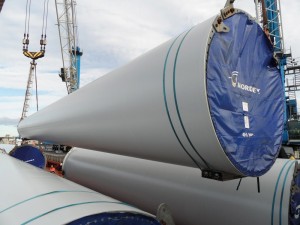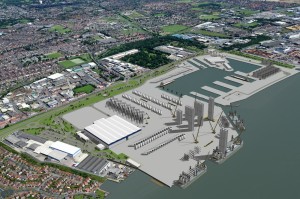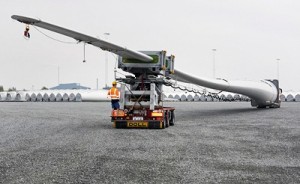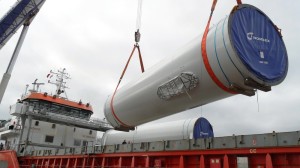Investing in the Future of UK Wind Energy
Gearing up for the UK’s Round Three of Offshore Wind projects, Siemens and Associated British Ports (ABP) have recently announced the investment of GBP 310 million into the development, at the Green Port of Hull, of two sites. One will be for the construction, assembly and service of turbine components and the other, a new rotor blade manufacturing facility. These features will call on the services of breakbulk and project cargo specialists, reports Port Industry’s Ben Littler.
The investment is just the kind envisioned by the UK Government Offshore Wind Industrial Strategy released late last year. The report aims to promote British involvement in project activity taking place in UK waters. It highlights the opportunities for UK-based businesses, but also acknowledges the challenges. Amongst these, the report says, is the need to develop a stronger supply chain, one that can compete more effectively with neighbouring EU states.
The Siemens – ABP venture at Hull goes some way to addressing this need. For the development Siemens is investing GBP 160 million and ABP GBP 150 million.
The decision to invest is a show of confidence in the UK offshore wind sector and governmental moves to prepare it for the future, as Michael Suess, CEO of Siemens’ Energy Sector and Managing Board member said: “Our decision to construct a production facility for offshore wind turbines in England is part of our global strategy: We invest in markets with reliable conditions that can ensure that factories can work to capacity. The British energy policy creates a favourable framework for the expansion of offshore wind energy. In particular it recognises the potential of offshore wind energy within the overall portfolio of energy production.”
Politically Correct
The project has attracted a lot of political attention, including a recent visit from British Prime Minister David Cameron and Energy and Climate Change Secretary Ed Davey, both of whom praised the investment for its economic benefits. James Cooper, CEO of ABP, spoke of how the development would help the port – and the Humber region – to service the future energy needs of the country. “The announcement by Siemens…underlines the critical role the Humber region plays in servicing the UK’s energy needs, both today and in the future. Our investment in Green Port Hull will ensure the supply chain supporting this exciting new industry can be centred on the Humber…”
The new facilities will form part of the Green Port of Hull project which has been in development over the past 4 years. A collaboration between ABP, Hull City Council and East Riding Council, the project aims to create a world-class renewable energy hub, capitalising on the port’s location close to Round 3 developments. A total of 500ha at the port and close-by are available for development, offering space for manufacturers, business parks, research and development facilities and operations and maintenance.
The project includes the regeneration of Alexandra Dock, the location of which, close to a deepwater channel, ensures suitability for the import and export of turbine components. The largest site available at the Green Port Hull is the 80ha at Paull. It is here that Siemens is developing its new rotor blade manufacturing facility.
As well as making major contributions to the offshore wind sector, Hull has featured recently in a number of projects for the facilitation of onshore wind installations. WWL ALS, who are headquartered at the port, have handled a number of turbines arriving on vessels, for their client Nordex. WWL ALS operate internationally, handling port operations as far away as South Africa. In the UK and Ireland they are the Nordex partner of choice and responsible for 100 percent of wind-based port operations.
Richard Platts, Senior Manager Projects Shipping, explains how the Port of Hull is particularly well suited to wind energy operations. “We also use Immingham, but to a lesser degree than Hull. This is because Hull is accessible to larger vessels, which is especially important as turbine components continue to get larger. Additionally Hull has some excellent hinterland connections for transporting turbine components.”
Mr Platts explains the essence of WWL ALS service offering: “Our project team provides a unique and comprehensive nationwide maritime and ports service to vessel owners, cargo owners and freight forwarders. Using the latest technology we attend vessels across the UK providing clients with the entire range of services necessary for a vessel call. It is a unique service – we are the only company to have fully qualified staff in the ships agency, cargo handling, chartering and marine cargo warranty surveying profession without subcontractors.”
Demonstrating just how big component parts for offshore wind farms are becoming, UK-based ALE Heavy Lift completed off-loading eight parts for a prototype turbine in Fife, Scotland. At 7mw one of the largest in the world.
The components offloaded by ALE’s 1,200t capacity Gottwald AK912-1 crane were as follows: Two 350t tower sections, one 525t nacelle, three 85m long blades each weighing 80t, one 480t jacket and one 475t ‘T’ piece.
“This is a great project to work on,” said Andrew Hurst, Project Engineering Manager at ALE. “The pieces were not out of the ordinary in terms of weight for us, however, with sections at 85m long, some preparatory work was done to ensure the stability and method for transportation.”











